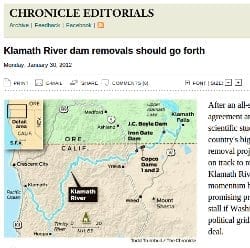The SF Chronicle On Klamath River Dam Removal: “This is one water war that should be called off.”
The Klamath River dams should come out.

Removing four Klamath River dams is good for fish, the economy.
That’s the conclusion of the best, peer-reviewed science available. Removal will help restore the Klamath’s once-abundant salmon and steelhead runs, and provide temporary and permanent jobs in what is one of California’s most economically depressed counties.
After looking at the data, the San Francisco Chronicle apparently agrees:
The latest update in the years-long effort is hundreds of pages of studies that give a fuller picture of the impact of taking out four dams that date back nearly a century and straddle the California-Oregon border. The findings expand on earlier work by adding compelling evidence that a free-flowing river will restore salmon runs, revive the sickly river, and still allow for irrigation water for Oregon farmers.
But partisan politics deepened by this November’s elections could disrupt the process. Interior Secretary Ken Salazar, who called for the studies, is due to make a decision on demolition in March. The weight of the findings plus the widespread local consensus for removal suggests he’ll give his blessing.
But the idea still needs support in Congress, where the outcome isn’t guaranteed. House Republicans are leery of taking out the dams, saying the benefits are uncertain. We suggest these doubters study pictures of the thousands of dead salmon in 2002, killed by warm dam flows, and then revisit the angry conflicts in 2001 between farmers and environmentalists over water diversions. The pending plan has the potential to end a rerun of either nightmare.
The science has been peer reviewed and is the best available, and many of the arguments against dam removal are little more than smoke and mirrors.
The San Francisco Chronicle has it right when they say:
This is one water war that should be called off. Washington has a duty to follow through on a deal, not prolong a harmful battle.
(You can read the entire SF Chronicle article here.)




